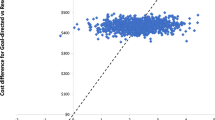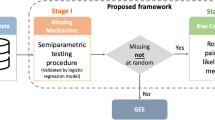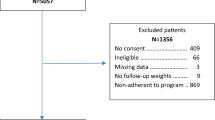Abstract
CONTEXT: Although most health insurers exclude coverage of weight control therapy, one local insurer offered partial reimbursement of the cost of a weight control program, using an incentive plan.
OBJECTIVE: To determine whether outcome-driven insurer-based reimbursement improves participation in a weight control program and short-term weight loss outcomes.
DESIGN: Cohort follow-up study between January 1998 and February 2001.
SETTING: Community weight management program operated by an academic medical center.
SUBJECTS: Obese participants who had the potential for reimbursement (Group A, n=25) and participants in the same program classes (Group B, n=100) who had no possibility for reimbursement. Subjects in Group B were selected from among 206 potential participants using a propensity score to match them with subjects in Group A on age, gender, ethnicity, starting BMI, starting weight, and educational, economic, and demographic variables.
INTERVENTION: Group lifestyle-based weight management program. The insurer reimbursed half the cost of the program to obese participants who met minimum weight criteria, paid the program fee at enrollment, attended ≥10 of the 12 classes, and lost ≥6% of initial body weight after 12 weeks.
MAIN OUTCOME MEASURES: Participation rates and weight loss outcomes.
RESULTS: Group A subjects attended significantly more classes (mean±s.d.: 10.1±1.8 vs 8.2±2.5, P<0.001) and lost more weight than Group B subjects (6.1±3.1 vs 3.7±3.6%, P=0.002). While 84% of Group A subjects attended ≥10 classes, only 37% of Group B subjects did so (P<0.001); 56% of Group A subjects lost ≥6% of body weight, but only 20% of Group B subjects did so (P<0.001); 56% of Group A subjects achieved both the class attendance and weight loss goals, but only 14% of Group B subjects did so (P<0.001). Logistic regression estimated that Group A subjects had 8.2 times the odds of attending ≥10 classes and 4.5 times the odds of losing ≥6% of body weight of Group B subjects, after controlling for class attendance.
>CONCLUSIONS: Insurer-based reimbursement that is contingent upon initial financial commitment on the part of the patient, consistent program participation, and successful weight loss is associated with significantly better short-term weight control outcomes.
This is a preview of subscription content, access via your institution
Access options
Subscribe to this journal
Receive 12 print issues and online access
$259.00 per year
only $21.58 per issue
Buy this article
- Purchase on Springer Link
- Instant access to full article PDF
Prices may be subject to local taxes which are calculated during checkout
Similar content being viewed by others
References
Flegal KM, Carroll MD, Ogden CL, Johnson CL . Prevalence and trends in obesity among US adults, 1999–2000. JAMA 2002; 288: 1723–1727.
Aronne LJ . Epidemiology, morbidity, and treatment of overweight and obesity. J Clin Psychol 2001; 62 (Suppl 23): 13–22.
Allison DB, Fontaine KR, Manson JE, Stevens J, VanItallie TB . Annual deaths attributable to obesity in the United States. JAMA 1999; 282: 1530–1538.
Fontaine KR, Redden DT, Wang C, Westfall AO, Allison DB . Years of life lost due to obesity. JAMA 2003; 289: 187–193.
Office of the Surgeon General. Overweight and obesity: at a glance. www.surgeongeneral.gov/topics/obesity/calltoaction/fact_glance.htm, accesses 17 February 2003.
Wolf AM, Colditz GA . The cost of obesity: the US perspective. PharmacoEconomics 1994; 5 (Suppl 1): 34–37.
Wolf AM, Colditz GA . Current estimates of the economic cost of obesity in the United States. Obes Res 1998; 6: 97–106.
Allison DB, Zannolli R, Narayan KM . The direct health care costs of obesity in the United States. Am J Public Health 1999; 89: 1194–1199.
Sturm R . The effects of obesity, smoking, and drinking on medical problems and costs. Health Affairs 2002; 21: 245–253.
Thompson D, Edelsberg J, Kinsey KL, Oster G . Estimated economic costs of obesity to U.S. business. Am J Health Promot 1998; 13: 120–127.
Bowerman S, Bellman M, Saltsman P, Garvey D, Pimstone K, Skootsky S, Wang H, Elashoff R, Heber D . Implementation of a primary care physician network obesity management program. Obesity Res 2001; 9 (Suppl 4): 321S–325S.
Martin LF, White S, Lindstrom Jr W . Cost–benefit analysis for the treatment of severe obesity. World J Surg 1998; 22: 1008–1017.
Tershakovec AM, Watson MH, Wenner Jr WJ, Marx AL . Insurance reimbursement for the treatment of obesity in children. J Pediatrics 1999; 134: 573–578.
Jeffery RW, Gerber WM, Rosenthal BS, Lindquist RA . Monetary contracts in weight control: effectiveness of group and individual contracts of varying sizes. J Consult Clin Psychol 1983; 51: 242–248.
Jeffery RW, Wing RR, Thorson C et al. Strengthening behavioral interventions for weight loss: a randomized trial of food provision and monetary incentives. J Consult Clin Psychol 1993; 61: 1038–1045.
Axsom D, Cooper J . Cognitive dissonance and psychotherapy: the role of effort justification in inducing weight loss. J Exp Social Psychol 1985; 21: 149–160.
Williams GC, Grow VM, Freedman ZR, Ryan RM, Deci EL . Motivational predictors of weight loss and weight-loss maintenance. J Pers Soc Psychol 1996; 70: 115–126.
Weinsier RL, Wilson NP, Morgan SL, Cornwell AR, Craig CB . EatRight lose weight: seven simple steps. Oxmoor House: Birmingham, AL; 1997.
Weinsier RL, Bacon JA, Birch R . Time–calorie displacement diet for weight control: a propective evaluation of its adequacy for maintaining normal nutritional status. Int J Obes Relat Metab Disord 1983; 8: 539–548.
Duncan KH, Bacon JA, Weinsier RL . The effects of high and low energy density diets on satiety, energy intake, and eating time of obese and nonobese subjects. Am J Clin Nutr 1983; 37: 763–767.
D'Agostino Jr RB . Propensity score methods for bias reduction in the comparison of a treatment to a non-randomized control group. Stat Med 1998; 17: 2265–2281.
Fitzwater SL, Weinsier RL, Wooldridge NH, Birch R, Bartolucci AA . Evaluation of long-term weight changes after a multidisciplinary weight control program. J Am Diet Assoc 1991; 91: 421–426, 429.
Perri MG, Nezu AM, Viegener BJ . Improving the longer-term management of obesity: theory, research and clinical guidelines. Wiley: New York; 1992.
Mokdad AH, Bowman BA, Ford ES, Vinicor F, Marks JS, Koplan JP . The continuing epidemic of obesity and diabetes in the United States. JAMA 2001; 286: 1195–1200.
Ford ES, Giles WH, Dietz WH . Prevalence of the metabolic syndrome among US adults. Findings from the third National Health and Nutrition Examination Survey. JAMA 2002; 287: 356–359.
Wadden GA, Foster GD, Wang J, Pierson RN, Yang MU, Moreland K, Stunkard AJ, VanItallie TB . Clinical correlates of short- and long-term weight loss. Am J Clin Nutr 1992; 56: 271S–274S.
Jeffery RW, Wing RR, Thorson C, Burton LR . Use of personal trainers and financial incentives to increase exercise in a behavioral weight-loss program. J Consult Clin Psychol 1998; 66: 777–783.
Internal Revenue Service Rev. Rul. 2002-19. Internal Revenue Bulletin 2002–16, April 22, 2002.
Cappelleri JC, Trochim WMK . Ethical and scientific features of cutoff based design: a simulation study. Med Decision Making 1995; 15: 387–394.
Trochim WMK, Cappelleri JC . Cutoff assignment strategies for enhancing randomized clinical trials. Control Clin Trials 1992; 13: 190–212.
Allison DB, Cappelleri JC, Carpenter KM . Design and analysis of obesity treatment and prevention trials. In: Dalton S (ed). Overweight and weight management: the health professional's guide to understanding and practice. Aspen: Gaithersburg, MD; 1997. pp 557–597.
Jeffery RW, Bjornson-Benson WM, Rosenthal BS, Lindquist RA, Johnson SL . Behavioral treatment of obesity with monetary contracting: two-year follow-up. Addict Behav 1984; 9: 311–313.
Jeffery RW, Wing RR . Long-term effects of interventions for weight loss using food provisions and monetary incentives. J Consult Clin Psychol 1995; 63: 793–796.
Wing RR, Jeffery RW, Pronk N, Hellerstedt WL . Effects of a personal trainer and financial incentives on exercise adherence in overweight women in a behavioral weight loss program. Obes Res 1996; 4: 457–462.
Acknowledgements
We appreciate the assistance of Beth A Baker, MS with some of the early statistical analyses. This work was supported in part by the UAB Clinical Nutrition Research Center, NIH Grant # P30 DK 56336.
Author information
Authors and Affiliations
Corresponding author
Appendix
Appendix
Table A1 provides HMO reimbursement plan height/weight eligibility criteria Table A1
Rights and permissions
About this article
Cite this article
Hubbert, K., Bussey, B., Allison, D. et al. Effects of outcome-driven insurance reimbursement on short-term weight control. Int J Obes 27, 1423–1429 (2003). https://doi.org/10.1038/sj.ijo.0802403
Received:
Revised:
Accepted:
Published:
Issue Date:
DOI: https://doi.org/10.1038/sj.ijo.0802403
Keywords
This article is cited by
-
Impacts of chronic disease prevention programs implemented by private health insurers: a systematic review
BMC Health Services Research (2021)
-
A Randomized Pilot Trial of a Full Subsidy vs. a Partial Subsidy for Obesity Treatment
Obesity (2012)
-
Effects of a Reimbursement Incentive on Enrollment in a Weight Control Program
Obesity (2007)
-
Use of incentives to motivate healthy behaviors among employees
Gender Issues (2003)



